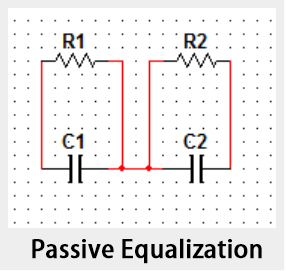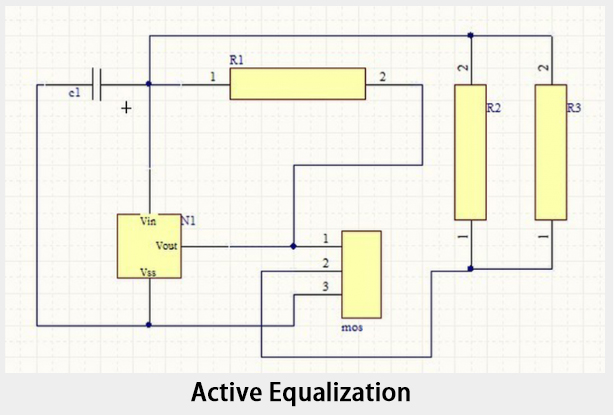1. EDLC module composition
EDLC modules are formed by connecting individual EDLC cells in series or parallel configurations, as shown in the figure:
2.Equalization method of individual cells within an EDLC module
The equalization methods for EDLC modules mainly include passive equalization and active equalization.
3. Passive Equalization
When capacitors are connected in series, there may be issues of voltage imbalance among the capacitors. This is mainly influenced by the capacitance and self-discharge characteristics of the capacitors. Therefore, when selecting capacitors to form a module, it’s important to carefully choose capacitors with matching capacitance to ensure voltage balance during constant current charging of the capacitor module. Additionally, each capacitor should be connected in parallel with a resistor to counteract the effects of self-discharge.
Since the self-discharge of each capacitor isn’t consistent, this can lead to different voltages among capacitors after storing a charged state for some time. Repeated charging and discharging can further exacerbate voltage differences between capacitors, and individual capacitors may exceed their rated voltage, thereby affecting the module’s lifespan. By measuring the leakage current of capacitors, the equivalent parallel resistance of the capacitors can be calculated. Based on the value of the equivalent parallel resistance, appropriate equalization resistors can be selected to achieve voltage balance.

4.Active Equalization
In addition to screening the capacitance of each capacitor, it’s also necessary to parallel a voltage equalization circuit across the terminals of each capacitor. The implementation of this equalization circuit involves using a voltage comparator with a set threshold value (usually around 2.6V). When the voltage of an individual capacitor is lower than this threshold value, the discharge circuit remains inactive. Conversely, when the voltage of an individual capacitor exceeds this threshold value, the other end of the voltage comparator becomes conductive. This parallelizes the discharge resistor across the terminals of the capacitor, allowing it to discharge through the resistor. This action leads to a decrease in the individual capacitor’s voltage. Once the voltage drops below the set threshold value, the voltage comparator switches to the other side, disconnecting the capacitor from the resistor and discontinuing the discharge.
This equalization method is primarily used for supercapacitor modules composed of high-capacity individual cells, such as a 48V module consisting of 18 cells in series, each with a capacitance of 3000F. The circuit configuration is typically as depicted in the diagram below:

5. Balance between modules
When connecting supercapacitor modules, it’s advisable to select products with consistent capacitance ranges to ensure that the voltage remains consistent within a certain range during module charging. On this foundation, voltage equalization is primarily achieved through balancing circuits.
For more information, please visit the official website of CDA-CAP: en.cda-cap.com
Introduction to CDA-CAP
CDA-CAP is dedicated to the field of supercapacitors and has evolved into a globally recognized manufacturer of high-quality supercapacitor components and a provider of supercapacitor system solutions. As of now, CDA-CAP’s supercapacitor products have been widely applied in 12 industries, including wind and solar energy, new energy vehicles, rail transportation, smart grids, microgrids, construction machinery, industrial energy efficiency, among others. Our clientele spans across 26 countries and regions in Asia, Europe, and North America, making us a prominent representative in China’s domestic supercapacitor market. Our contributions have significantly contributed to the rapid expansion of supercapacitor applications in the Chinese market.
 English
English Chinese
Chinese
